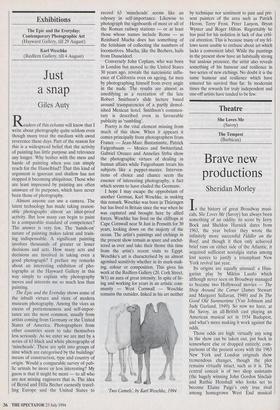Exhibitions
The Epic and the Everyday: Contemporary Photographic Art (Hayward Gallery, till 29 August) Karl Weschke (Redfern Gallery, till 4 August)
Just a snap
Giles Auty
Readers of this column will know that I write about photography quite seldom even though many treat the medium with awed reverence these days. Part of the reason for this is a widespread belief that the activity of painting has little purpose and relevance any longer. Why bother with the mess and hassle of painting when you can simply reach for the Hasselblad? That this kind of argument is ignorant and shallow has not stopped it becoming ubiquitous. Those who are least impressed by painting are often unaware of its purposes, which have never been those of photography.
Almost anyone can use a camera. The latest technology has made taking reason- able photographs almost an idiot-proof activity. But how many can begin to paint to a comparable standard of competence? The answer is very few. The 'hands-on' nature of painting makes talent and train- ing indispensable. A significant painting involves thousands of greater or lesser decisions and acts. How many acts and decisions are involved in taking even a good photograph? I preface my remarks about an interesting exhibition of pho- tographs at the Hayward Gallery in this way simply to explain why photography moves and interests me so much less than painting.
The Epic and the Everyday shows some of the inbuilt virtues and vices of modern museum photography. Among the vices an excess of portentousness and self-impor- tance are the most common, usually from artists coming from Germany or the United States of America. Photographers from other countries seem to take themselves less seriously. As we enter we are met by a series of 63 black and white photographs of `mineheads'. These are split into groups of nine which are categorised by the buildings' means of construction, type and country of origin. Would a comparable survey of pub- lic urinals be more or less interesting? My guess is that it might be more — to all who are not mining engineers that is. The idea of Bernd and Hilla Becher earnestly travel- ling Europe and the United States to
record 63 `mineheads' seems like an odyssey in self-importance. Likewise to photograph the signboards of most or all of the Roman railway stations — or at least those whose names include Rome — as Reinhard Mucha does has something of the fetishism of collecting the numbers of locomotives. Mucha, like the Bechers, hails from Dusseldorf.
Conversely John Coplans, who was born in London but moved to the United States 30 years ago, reveals the narcissistic influ- ence of California even on ageing, fat men by photographing himself from every angle in the nude. The results are almost as unedifying as a recreation of the late Robert Smithson's slide lecture based around transparencies of a partly demol- ished Mexican hotel. Smithson's commen- tary is described even in favourable publicity as 'rambling'.
Poetry is the vital element missing from much of this show. When it appears it comes principally from photographers from France — Jean-Marc Bustamante, Patrick Faigenbaum — Mexico and Switzerland. Gabriel Orozco and Annelies Strba show the photographic virtues of dealing in human affairs while Faigenbaum treats his subjects like a puppet-master. Interven- tions of choice and chance seem the essence of interesting photography, a fact which seems to have eluded the Germans.
I hope I may escape the opprobrium of another German, Karl Weschke, in making this remark. Weschke was born in Thuringen but has lived in Britain since the war when he was captured and brought here by allied forces. Weschke has lived on the clifftops at Cape Cornwall near St Just in Penwith for 30 years, looking down on the majesty of the ocean. The artist's paintings and etchings in the present show remain as spare and unclut- tered as ever and take their theme this time from the artist's recent visits to Egypt. Weschke's art is characterised by an almost agonised sensitivity whether in its mark-mak- ing, colour or composition. This gives his work at the Redfern Gallery (20, Cork Street, W1) an aura of great intensity. In spite of liv- ing and working for years in an artistic com- munity — West Cornwall — Weschke remains the outsider, linked in his art neither 'Two Camels', by Karl Weschke, 1994 by technique nor sentiment to past and pre- sent painters of the area such as Patrick Heron, Terry Frost, Peter Lanyon, Bryan Wynter and Roger Hilton. Regrettably he has paid for his isolation in lack of due criti- cal attention. This is because many of my fel- lows seem unable to enthuse about art which lacks a convenient label. While the paintings in the present show have an habitually strong but anxious presence, the artist also reveals something of his humour and resilience in two series of new etchings. No doubt it is the same humour and resilience which have ensured his survival thus far. In modernist times the rewards for truly independent and one-off artists have tended to be few.


















































 Previous page
Previous page